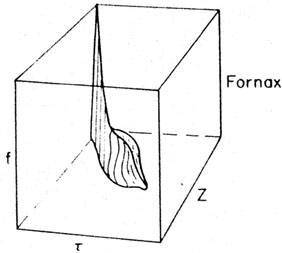Copyright © 1989 by Annual Reviews. All rights reserved
| Annu. Rev. Astron. Astrophys. 1989. 27:
139-59 Copyright © 1989 by Annual Reviews. All rights reserved |
5.11 Fornax
Only a little less luminous than NGC 147, Fornax is the brightest of the Local Group's extreme dwarf ellipticals. It is sufficiently massive that it has its own family of six globular clusters (58), and it marks the boundary between the ellipticals that do (all of those brighter than Fornax) and the ellipticals that do not (all of those fainter). Information on the stellar populations in these galaxies comes from color-magnitude diagrams, variable star studies, and measurements of the characteristics of their carbon stars; see reviews by Aaronson et al. (6), Zinn (136), DaCosta (30), Aaronson (1), and Aaronson & Olszewski (5).
For Fornax, there is evidence of an overall dominance of very old stars [as shown by CMDs published by Demers et al. (35), Buonanno et al. (20), and Gratton et al. (52) and confirmed by the luminosity function derived by Eskridge (39)]. The globular clusters (20, 31, 55, 58, 125, 137) have integrated colors and CMDs that are very similar to those of normal old globular clusters in the Galaxy, which also indicates that a 15-Gyr-old population exists in the Fornax system.
However, it is clear that there are also younger stars in Fornax, as is shown by the width of the giant branch (35), the presence of faint, blue, probable main sequence stars (20), and the existence of large numbers of luminous carbon stars (4, 34, 46, 103, 130). Therefore, the star formation history of Fornax (Figure 14) looks something like that of NGC 205, except that star formation stopped about 3 Gyr ago. The figure shows a widening of the volume, indicative of the spread in metal abundances suggested by the CMDs.

|
Figure 14. The population history of the Fornax dwarf elliptical. |